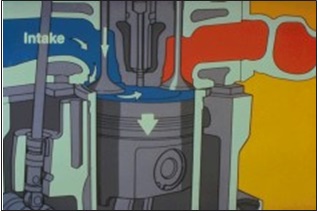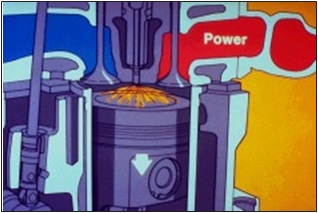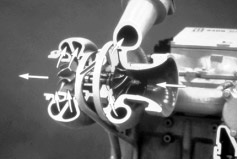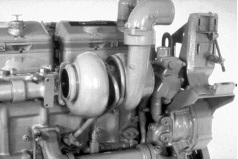Inlet Manifold
From the air cleaner (turbocharger/aftercooler, if equipped) the incoming air enters the inlet manifold. The inlet manifold directs the air into the cylinder head.

Intake Stroke
Air fills the inlet ports in the cylinder head. On the INTAKE stroke as the piston travels down in the cylinder the intake valves open, and air fills the volume of the cylinder.

Compression Stroke
On the COMPRESSION stroke, as the piston begins to travel up, the intake valves close. The air that is trapped in the cylinder is compressed. Compressing the air raises the air temperature to a point where it will cause fuel to ignite when it is injected into the cylinder.

Power Stroke
When the piston nears the top of its travel, fuel is injected into the cylinder. The fuel mixes with the hot air and combustion begins. The energy released by the combustion forces the piston down producing the POWER stroke.

Exhaust Stroke
Near the end of the POWER stroke the exhaust valves open. Any residual pressure from combustion will rush into the exhaust manifold. On the upward or EXHAUST stroke the gases are pushed out of the cylinder by the piston. At the top of the stroke the exhaust valves close and the cycle starts over.

Exhaust Flow
Exhaust gases leaving the cylinder enter the exhaust manifold and are then routed to the turbocharger, if equipped.
The hot exhaust gases flowing out of the cylinders contain substantial unused heat energy. The turbocharger exhaust turbine captures some of this heat energy.

Turbocharger Operation
The exhaust gases flow past the blades of the turbine wheel and cause the turbine wheel to rotate. The turbine wheel is connected by a shaft to the compressor wheel. The exhaust gases push the turbine and subsequently the compressor wheel to a high RPM, about 80,000 - 130,000 RPM. This causes the intake air to be compressed.
When the load on the engine increases, more fuel is injected into the cylinders. The increased combustion generates more exhaust gases causing the turbine and compressor wheel to turn faster. As the compressor wheel turns faster, more air is forced into the engine.The maximum rpm of the turbocharger is controlled by the fuel setting, the high idle speed setting and the height above sea level.

Exhaust Flow
From the turbocharger (if equipped), the exhaust gases pass through the exhaust pipe, the muffler, and the exhaust stack.